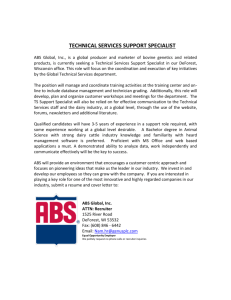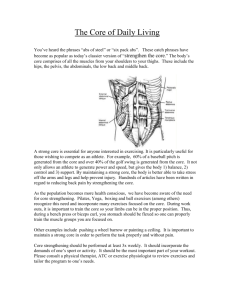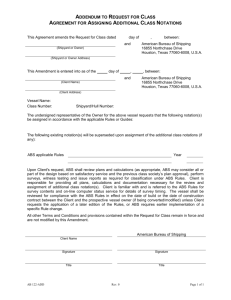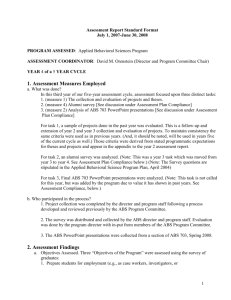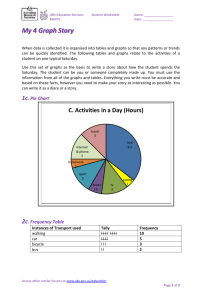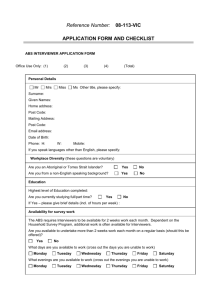applied behavioral science
advertisement
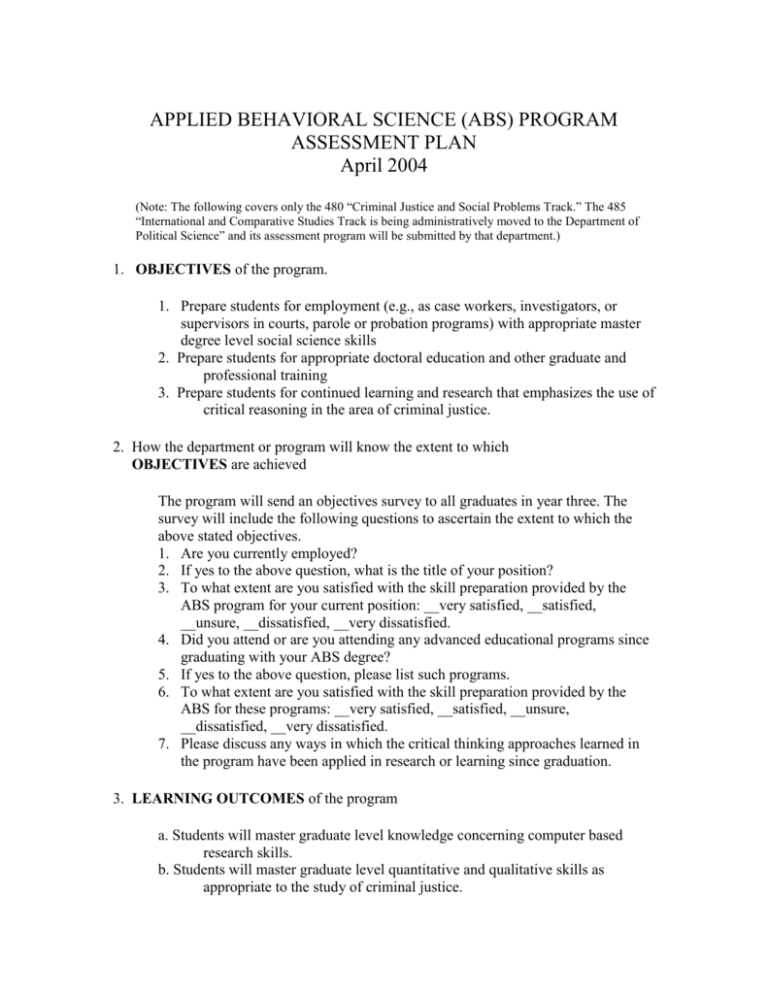
APPLIED BEHAVIORAL SCIENCE (ABS) PROGRAM ASSESSMENT PLAN April 2004 (Note: The following covers only the 480 “Criminal Justice and Social Problems Track.” The 485 “International and Comparative Studies Track is being administratively moved to the Department of Political Science” and its assessment program will be submitted by that department.) 1. OBJECTIVES of the program. 1. Prepare students for employment (e.g., as case workers, investigators, or supervisors in courts, parole or probation programs) with appropriate master degree level social science skills 2. Prepare students for appropriate doctoral education and other graduate and professional training 3. Prepare students for continued learning and research that emphasizes the use of critical reasoning in the area of criminal justice. 2. How the department or program will know the extent to which OBJECTIVES are achieved The program will send an objectives survey to all graduates in year three. The survey will include the following questions to ascertain the extent to which the above stated objectives. 1. Are you currently employed? 2. If yes to the above question, what is the title of your position? 3. To what extent are you satisfied with the skill preparation provided by the ABS program for your current position: __very satisfied, __satisfied, __unsure, __dissatisfied, __very dissatisfied. 4. Did you attend or are you attending any advanced educational programs since graduating with your ABS degree? 5. If yes to the above question, please list such programs. 6. To what extent are you satisfied with the skill preparation provided by the ABS for these programs: __very satisfied, __satisfied, __unsure, __dissatisfied, __very dissatisfied. 7. Please discuss any ways in which the critical thinking approaches learned in the program have been applied in research or learning since graduation. 3. LEARNING OUTCOMES of the program a. Students will master graduate level knowledge concerning computer based research skills. b. Students will master graduate level quantitative and qualitative skills as appropriate to the study of criminal justice. c. Students will master formal graduate writing skills appropriate for the creation of graduate theses/projects and research articles. d. Students will master the skills of reviewing applied programs (e.g., a program for felons whose crimes are tied to alcohol abuse) in terms of the extant literature, logical cohesion and current empirical knowledge. e. Students will be able to use their skills in the creation and administration of applied programs in both public and private agencies. 4. MEASURES that will be used to assess learning The following measures will be used: 1. An analysis of completed projects and theses. (Project rules attached.) 2. An analysis of ABS 702 final exams and ABS 703 PowerPoint research proposal presentations. (ABS 702 focuses on statistical analytical skills.) 3. Focus groups of graduates working in the field 4. An alumni survey. (This “learning outcomes” survey will differ from the “objectives” survey. It also will not be sent to all past graduates, but rather to a sample of those graduated within the past five years.) Learning Outcome a. Learning Outcome b. Learning Outcome c. Learning Outcome d. Learning Outcome e. will be measured by measures 1, 3 and 4 will be measured by measures 1 and 2 will be measured by measures 1 and 2 will be measured by measures 3 and 4 will be measured by measures 3 and 4 5. How learning outcomes are made MEASURABLE and BENCHMARKS or other determinants of success are set. 1. Projects and theses should be error free in terms of punctuation and grammar. They should have clear abstracts, literature reviews and other features as specified in the project proposal statement of the program. (See attached ABS Project.) Graphs, charts and tables should conform to academic standards in the APA style manual. 2. ABS 702 finals should show that students can analyze 90% of statistical procedures specified in course syllabus. PowerPoint research proposals should conform 90% to specified program model 3. Focus group members should reach consensus that students have the appropriate skills for research and program evaluation. 4. Survey questions should average over 80% agreement that the program is meeting its learning outcomes. 6. Process by which FINDINGS will be derived from the measures. The process will be under the control of the ABS program committee. That committee will specify which faculty will be involved with each measure. All program faculty will be given the opportunity to take part in the process. These findings will be collated by the program director and communicated with the program faculty. 7. The process by which findings are analyzed to determine what IMPROVEMENTS should be made to better meet objectives and learning outcomes. Findings will be analyzed by the program committee. The program committee will ask the following questions in regards to each finding: 1. What are the areas of strength and weaknesses in regards to program outcomes? 2. How should courses and other requirements be modified to better meet outcomes? 3. How should the admission and advising processes be modified to better meet outcomes? 8. Identify a TIMETABLE for assessment. A five year cycle will be used. Year 1: Collect and evaluate ABS projects and theses; construct and pre-test “learning outcomes” alumni survey Year 2: Collect and evaluate ABS projects and theses; mail and evaluate “learning outcomes” alumni survey Year 3: Collect and evaluate ABS projects and theses; analyze results from ABS 702 and 703, and mail alumni and evaluate “objectives” survey Year 4: Collect and evaluate projects and theses; hold focus groups Year 5: Collect and evaluate projects and theses; review assessment procedures and implement changes. 9. How the program’s assessment plan supports and interacts with ACCREDITATION and LICENSURE requirements. Not Applicable 10. Describe how the objectives and learning outcomes of the program are COMMUNICATED to students and others. Objectives and Outcomes will be presented on program website and be included on future printings of the program brochure. The ABS Project The ABS project is a capstone endeavor intended for students who choose not to write a traditional thesis. Although its format is different from a traditional thesis, the project is designed to be a rigorous academic achievement that draws on the knowledge and skills obtained by the student in the seminars, workshops, and other required and elective program activities. The following guidelines should guide the student in the development and execution of the project. Although exceptions can be made to these guidelines, the burden is on the student to delineate, justify and propose any alternatives to them. Minor exceptions will be reviewed by the program director; major exceptions must take the form of a petition submitted to the program committee. 1. The project may be based on quantitative or qualitative data of a quality generally acceptable in the social sciences. 2. The project may take the form of a case study or a comparative study. 3. The project must present the applied/practical use of its conclusions and indicate implications for further research. 4. Projects will be presented in the format of a social science journal article. (Accordingly, they will normally contain, in order: an academic title, an abstract, a statement of the research problem, a literature review, a statement of methodology, a summary of quantitative and/or qualitative data, conclusions drawn from data, and applied implications.) 5. The particular journal being used as a stylistic model must be approved by the program director. 6. Citations, notes and references must be in a style generally acceptable in the social sciences. 7.Two double-spaced hard copies and a copy sent as an e-mail attachment of the final approved project must be submitted to the program director. 8. All graphs, charts, diagrams and other illustrative devices must be presented and labeled in a manner generally used in the social sciences. 9. All work (excepting assistance from a statistical consultant) must be the original work of the degree candidate. 10. All necessary approvals from any university committee and/or any outside agencies are the candidate’s responsibility. 11. Copyright holder approval for any material that does not fall into the category of ‘fair use’ is the candidate’s responsibility. 12. All projects need written prior approval from the director and project adviser on a form approved by the program committee. 13. All projects must be revised until they receive written final approval from the project adviser and acceptance by the program director. 14. Project research must take place after the student is enrolled in the program. 15. Although the project may build on information and experience gained in professional employment, it is not to be work that forms part of the student’s regular employment activities. 16. The project may be either new work or an expansion of previous course work, but in the latter case must extend beyond the course work in terms of scope, depth, and sophistication. 17. Final acceptance of the project will only take place after the candidate has submitted it to a conference or journal approved by the director. 18. These guidelines will cover all projects submitted after 15 June 2000. 19. These guidelines may only be revised by the ABS program committee.


